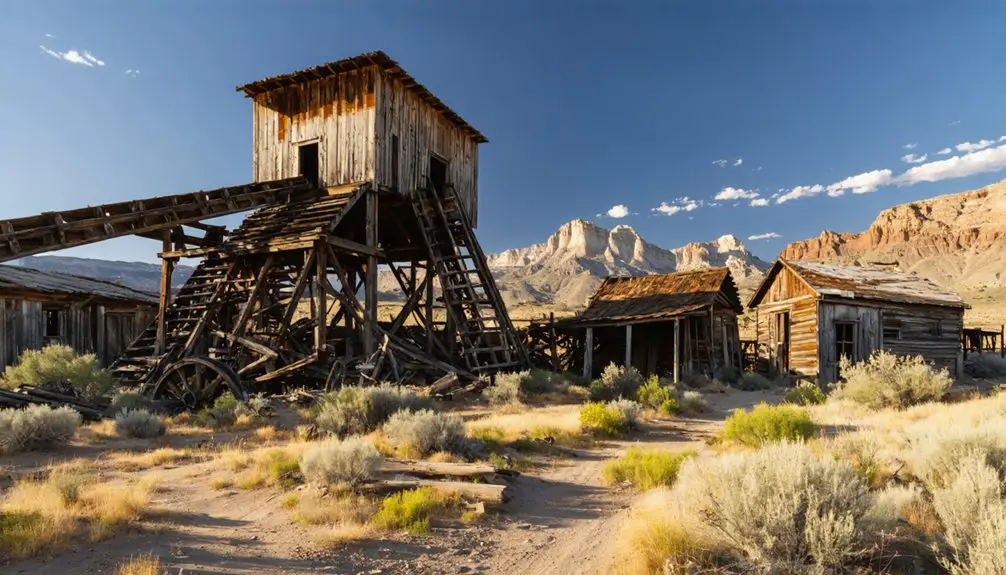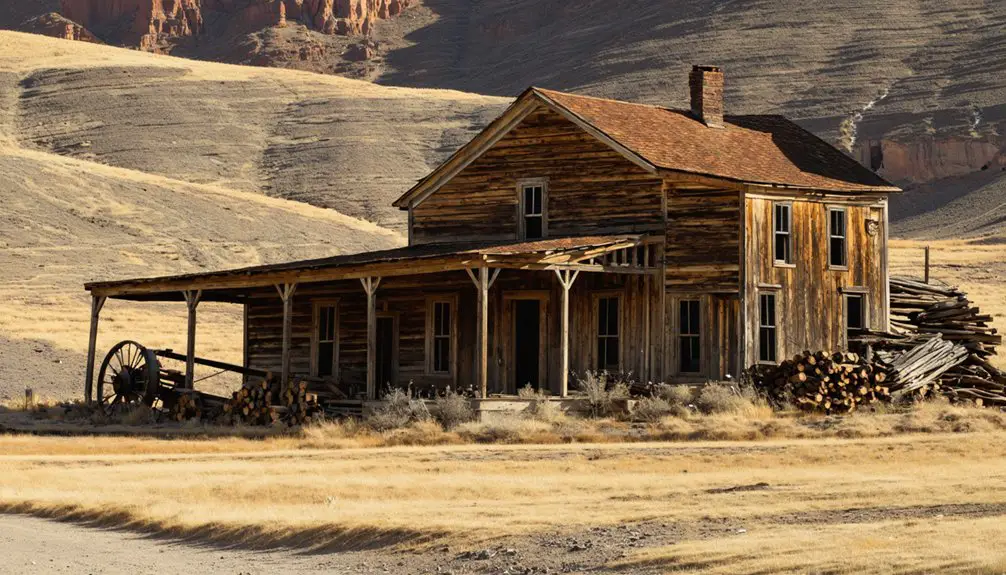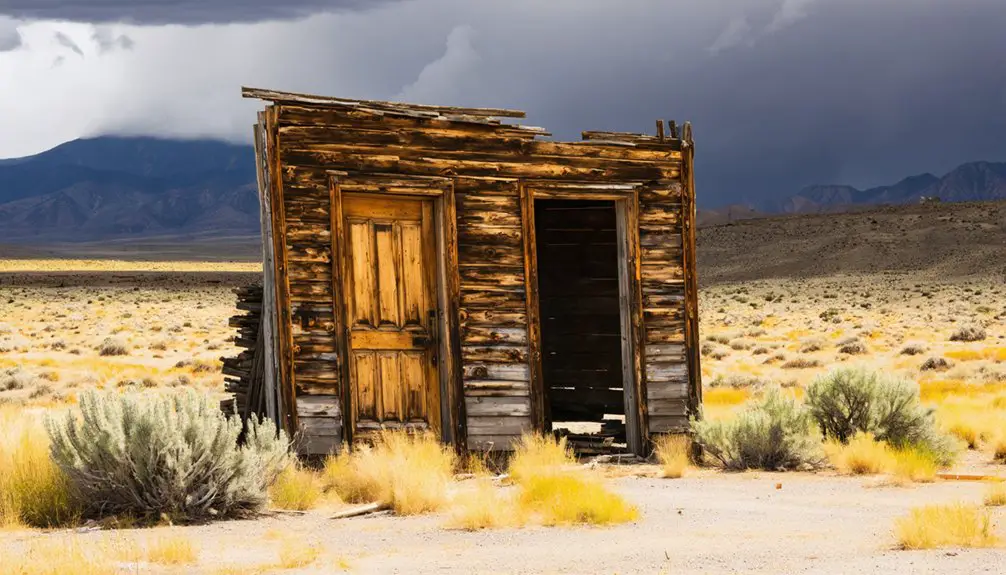You’ll discover Vipont nestled at 7,402 feet in Box Elder County’s Ashbrook Mining District, where silver mining operations flourished in the late 1800s. The town’s complex polymetallic veins yielded 3.44 million ounces of silver before economic challenges forced its closure. Workers endured 10-hour shifts in challenging underground conditions, living in simple wooden cabins with basic amenities. Today, deteriorating structures and archaeological evidence tell a compelling story of Utah’s mining heritage that goes far deeper than surface remains.
Key Takeaways
- Vipont was a silver mining town in Box Elder County, Utah, situated at 7,402 feet in the Ashbrook Mining District.
- The mine produced 3.44 million ounces of silver before economic challenges and labor issues led to its abandonment.
- Nearly 300 workers and families lived in wooden cabins, working 10-12 hour shifts in challenging underground conditions.
- The town’s decline began after the 1907 Panic, with a brief revival in 1920 before final abandonment mid-century.
- Today, Vipont exists as a ghost town with visible mining structures and artifacts, attracting historians, photographers, and tourists.
The Discovery of Silver in Vipont’s Mountains
While the exact date of Vipont’s initial silver discovery remains unclear, this remarkable mineral deposit emerged in Box Elder County, Utah’s Ashbrook Mining District at an elevation of 7,402 feet.
The silver discovery wasn’t made through surface prospecting but rather through the identification of ore minerals in place, leading to extensive underground workings in the Vipont Mountains.
You’ll find that by the 1920s, the mine had become a significant contributor to Utah’s silver production, helping the state become the nation’s largest silver producer in 1923.
The mining geology revealed a complex polymetallic vein system that yielded not just silver, but also gold, lead, copper, and zinc.
The Vipont Silver Mining Company capitalized on these rich deposits, generating impressive profits of around $1,000 daily during peak operations.
Operating under private ownership, the mine became part of the Vipont Mining Company’s holdings by 1979.
By the 1950s, operations slowed significantly when mining costs were determined to be prohibitively high.
Life During the Mining Boom Years
You’d find miners beginning their grueling 10+ hour workdays before dawn, descending into Vipont’s shafts with basic tools and limited lighting to extract silver ore in teams.
After their shifts, workers would gather at the camp’s wooden shacks and tents, which served as makeshift homes for the fluctuating population of laborers and their families.
The town’s social life centered around the general store and saloon, where miners could purchase supplies, exchange news, and find brief respite from their demanding underground work. Many of the skilled stoneworkers were European immigrants who brought their expertise to the mining operations. Later explorations of the mines were hampered by stagnant water that filled many of the larger tunnels.
Daily Worker Routines
During the mining boom years at Vipont, miners endured grueling daily routines that began before sunrise at the 7,402-foot elevation site. You’d find these hardy workers maneuvering narrow vertical fissures and steep slopes, armed with basic tools like picks and shovels.
Despite minimal miner safety protocols, they’d spend 8-12 hours underground drilling, blasting, and hand-loading ore into 200-pound burlap sacks. Work culture demanded efficiency – breaks were brief and taken near workstations.
You’d see miners constantly battling dust and confined spaces while maintaining vital ventilation shafts. After their shifts, they’d service equipment and prepare for the next day’s tasks.
During economic booms, you’d witness increased production demands, while downturns meant reduced hours or layoffs. The completion of the Uintah Railway eventually eased the strain of ore transport.
Community and Social Life
As Vipont’s population swelled with fortune-seeking miners in the boom years, a vibrant social fabric emerged despite the harsh mountain conditions.
You’d find miners and their families gathering at the local saloons, boarding houses, and general stores, where community gatherings helped forge strong bonds. Social clubs formed naturally, providing outlets for entertainment and mutual support in this isolated setting.
- Saloons hosted lively evenings of music, dancing, and storytelling
- Baseball games and boxing matches drew crowds seeking entertainment
- Religious services and holiday celebrations strengthened community ties
- Informal social gatherings at boarding houses built lasting friendships
Though life was challenging, you’d witness remarkable resilience as residents created a tight-knit community.
Women running boarding houses and shops played essential roles in maintaining social stability, while ethnic diversity brought rich cultural traditions to shared celebrations.
Transportation and Infrastructure Development
While Vipont’s mining operations thrived, its transportation infrastructure played an essential role in the town’s development. You’ll find evidence of an early rail system through buried rail ties and metal remnants, which once supported vital ore transport from the mines.
The town faced significant transportation challenges due to its remote desert location, relying primarily on unpaved roads suitable for horse-drawn and early motorized vehicles. Sheet metal and timber materials found in remaining structures indicate the town’s reliance on basic construction resources that could be transported to the remote location. The presence of invasive cheatgrass near transportation routes has increased wildfire risks in recent years.
Infrastructure limitations were particularly shaped by water scarcity and social segregation. Archaeological findings reveal separate Chinese and non-Chinese worker areas, suggesting divided access to transport routes.
After the Lucin Cutoff railroad opened in 1902, diverted train traffic impacted local rail usage.
Today, you’ll see Vipont remains well-preserved, though access is restricted due to private property ownership and unsafe mine tunnels.
Economic Challenges and Mining Operations
You’ll find that Vipont’s mining operations experienced dramatic economic fluctuations, with the most significant downturn occurring when federal silver purchase support ended under the Pittman Act in 1923.
The polymetallic nature of the deposits, which included silver, gold, lead, copper, and zinc, required complex and costly extraction methods at the underground site’s 7,402-foot elevation. The mine produced an impressive 3.4 million ounces of silver throughout its operational history.
While specific production data remains limited, the mine’s struggles with labor costs and operational viability ultimately led to its closure, contributing to Vipont’s transformation into a ghost town.
Mining Boom and Bust
The mining history of Vipont began in 1864 with initial prospecting in the Ashbrook district, followed by the first claim staked in 1873 and formal district organization in 1874. The geological formations, rich in silver and gold, attracted miners who developed underground mining techniques to extract ore from Paleozoic quartzites and carbonates.
- The Vipont mine reached its peak production during 1920-1924, yielding impressive silver-gold outputs.
- Operations halted abruptly in 1941 due to WWII federal mine closures.
- Mining resumed only for tailings reprocessing from 1978-1984 through heap leaching.
- Total production reached 180,000 tons of ore, yielding 3.44 million ounces of silver.
The boom-and-bust cycle was heavily influenced by government policies, including the Pittman Silver Purchase Act’s end in 1923, which forced the Vipont Silver Mining Co. to cease operations.
Labor and Wage Issues
Mining operations in Vipont faced significant labor challenges that shaped both worker conditions and economic outcomes throughout its active years.
Following the economic hardships of the 1933 New Deal, miners gained stronger organizational rights and union representation through UMWA’s re-establishment. You’ll find that wage disparities became a pressing concern when miners endured cuts of 10-30% during economic downturns, particularly following the Panic of 1893. Labor negotiations often turned contentious as the United Mine Workers of America fought for recognition against resistant mining companies.
As metal prices fluctuated in global markets, miners’ livelihoods hung in the balance. The historic “no contract, no work” policy demonstrated miners’ determination to secure fair treatment through collective action.
Workers eventually secured vital benefits, including standardized work schedules, death benefits of $1,000 for dependents, and safety improvements through joint industry committees.
The establishment of welfare funds, supported by coal tonnage royalties, provided essential protection for mining families during uncertain times.
Silver Production Challenges
While attempting to extract valuable silver deposits, Vipont’s operations confronted a complex web of geological and technological hurdles that considerably impacted production capabilities.
You’ll find that the polymetallic nature of the ore bodies required sophisticated ore processing methods to separate silver from copper, lead, zinc, and gold. At 7,400 feet elevation, the mine’s remote location complicated the transport of equipment and supplies, while underground workings demanded substantial infrastructure investment.
- Unpredictable extraction yields resulted from irregular underground ore bodies
- Complex mineralization required specialized knowledge and equipment for processing
- Limited mechanization and technology of the era restricted productivity
- Competition from larger producers in Utah pressured pricing and investment returns
The combination of these challenges, along with volatile silver prices, created persistent operational difficulties that affected the mine’s long-term sustainability.
Daily Life in a Remote Mining Town
Living in Vipont during its 1920s silver boom meant adapting to harsh conditions and isolation, as nearly 300 workers and their families clustered in simple wooden cabins near the mine site.
Isolated in rustic cabins near Vipont’s silver mines, three hundred souls carved out a rugged existence during the 1920s boom.
For mining families, daily routines revolved around grueling 10-12 hour shifts six days a week. You’d find most homes lacking indoor plumbing, with outhouses dotting the landscape. Remote living meant you’d rely heavily on the general store for basic supplies, though delayed shipments often tested your resourcefulness. The discovery of precious metals made the harsh lifestyle worthwhile, as miners sought their golden opportunity for wealth.
Social life centered around impromptu gatherings, the local saloon, or casual meetups at neighbors’ homes. You’d travel mostly by foot or horseback on dirt roads, and your children would attend makeshift schools.
The tramway’s rumbling and mine operations set the rhythm of daily life, while company scrip often replaced cash for your purchases.
The Decline and Abandonment

Despite initial prosperity during the gold and silver booms, Vipont’s decline began sharply with the Panic of 1907, which devastated the mining industry’s economy.
The replacement of legal tender with worthless scrip undermined miners’ wages, triggering a severe economic decline. You’ll find that this financial instability led to widespread mine closures and a dramatic population exodus as workers sought opportunities elsewhere.
The town’s final demise accelerated when the general merchant relocated inventory to neighboring settlements.
- Mining operations attempted revival in 1910, employing 300 workers and constructing a new tramway
- Silver-rich ore discovery in 1920 sparked brief resurgence
- Ore shipments continued into the 1940s but at diminishing scale
- Abandoned buildings and mining facilities deteriorated without maintenance, sealing Vipont’s fate as a ghost town
Present-Day Site and Accessibility
Situated near the southern base of the Raft River Mountains in Box Elder County, Utah, Vipont’s remnants stand at coordinates 41°49′25″N 113°26′32″W, approximately 6 miles west of Park Valley.
Today, you’ll find deteriorating mining infrastructure, including tramway foundations and mill sites, scattered across the semi-arid landscape. Access routes consist primarily of unpaved mountain roads requiring high-clearance or 4WD vehicles, with no formal signage or visitor facilities available.
Visitor safety is a significant concern due to unstable structures and open mine shafts. You’ll need to bring all necessary provisions, as there are no amenities on-site.
Weather conditions, particularly snow in winter and spring rains, can affect road accessibility. Before visiting, you should research local regulations, as the site may span both public and private land, requiring proper permissions for access.
Historical Preservation Efforts

Recent archaeological excavations at Vipont have transformed our understanding of this former mining settlement’s social fabric. Through detailed artifact analysis, researchers have uncovered evidence of Chinese residents and their daily lives, including currency, porcelain fragments, and food remnants.
The Utah Ghost Town Project now collaborates with historical groups to preserve these discoveries and engage the community through educational initiatives.
- Archaeological findings reveal previously undocumented Chinese businesses and living spaces
- Historical documentation combines photography, research, and public accessibility through digital platforms
- Interpretive trails and structural preservation help visitors visualize the town’s authentic past
- Community engagement through public lectures and educational outreach connects discoveries to broader historical themes
These preservation efforts guarantee Vipont’s complete history, including its overlooked populations, won’t be forgotten.
You’ll find ongoing updates and contributions from historians continuing to shape our understanding of this remarkable site.
Legacy in Utah’s Mining Heritage
Vipont Mine stands as a cornerstone of Utah’s silver mining heritage, producing over 3.4 million ounces of silver during its operational peak in the 1920s.
The historic Vipont Mine exemplifies Utah’s rich mining legacy, yielding millions of ounces of precious silver during America’s mining boom.
You’ll find its mining techniques evolved from traditional underground workings to modern heap leaching, showcasing the advancement of mineral extraction methods over time.
The mine’s geological significance stems from its location in the Ashbrook mining district, where complex Paleozoic formations and Miocene intrusive bodies created ideal conditions for silver mineralization.
When you explore Vipont’s history, you’ll discover it helped establish Utah as the nation’s leading silver producer in 1923, generating impressive daily profits of $1,000.
Even today, the mine’s remaining resources of over 2 million ounces of silver continue to represent Utah’s enduring mineral wealth and technological progress in mining operations.
Frequently Asked Questions
Were There Any Documented Deaths or Accidents in Vipont’s Mines?
You won’t find specific mine safety records or accident reports documenting deaths in Vipont’s mines, though nearby Utah mining towns experienced major disasters that were thoroughly documented during that era.
What Native Wildlife Species Were Commonly Encountered Around the Mining Town?
Like sentinels of the wilderness, you’d spot mountain lions, mule deer, and golden eagles around Vipont’s peaks, while coyotes, badgers, and rattlesnakes roamed the desert mining grounds below.
Did Any Famous Outlaws or Historical Figures Visit Vipont?
You won’t find records of famous outlaw encounters or historical visits to Vipont – it was primarily a mining operation that attracted workers and entrepreneurs rather than notable figures or Wild West legends.
What Was the Average Temperature and Weather Conditions Throughout the Year?
You’d face scorching 100°F+ days in summer and bitter -15°F lows in winter. Throughout the year, climate patterns showed dramatic seasonal variations with mostly dry conditions and sparse rainfall.
Were There Any Schools or Churches Established During Vipont’s Peak Years?
You won’t find documented school history or church activities during Vipont’s peak years. Historical records and artifacts don’t confirm any established educational or religious facilities in this brief mining settlement.
References
- https://en.wikipedia.org/wiki/Golden
- https://www.visitutah.com/things-to-do/history-culture/ghost-towns
- https://scholarlypublishingcollective.org/uip/uhq/article/71/3/215/203847/Vipont-Utah-A-Lost-and-Almost-Forgotten-Ghost-Town
- https://www.mojaveunderground.com/forum/forum/adventure/mines/888-vipont-mine-area-nw-corner-of-utah
- https://scholarlypublishingcollective.org/uip/uhq/issue/71/3
- https://westernmininghistory.com/mine-detail/10087193/
- https://westernmininghistory.com/mine-detail/10154661/
- https://ugspub.nr.utah.gov/publications/uranium_data/MD00830.pdf
- https://ugspub.nr.utah.gov/publications/uranium_data/MD00826.pdf
- https://www.uen.org/utah_history_encyclopedia/m/MINING.shtml



